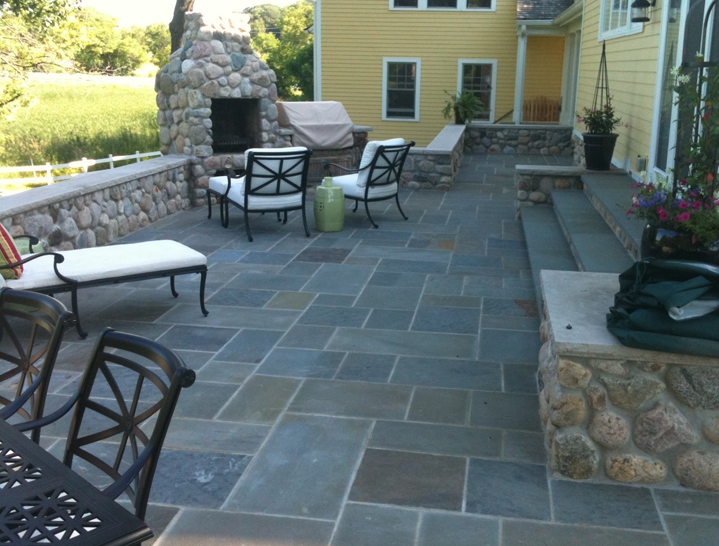Patio stone
Contents |
Introduction
Patios can be a great place to socialise and relax, as well as adding extra value to a property. But there are a lot of things to consider when it comes to having the perfect patio. One of the things that must be considered is the type of stone to use, and there are a lot to choose from.
Sandstone
One of the most popular choices when it comes to choosing stone paver is sandstone. Sandstone is incredibly easy to install as well as being very durable and versatile, making it long-lasting – perfect for the patio environment.
However, it is important to ensure that it is sealed correctly because sandstone succumbs to staining easily. Also, when cleaning sandstone, make sure to stay away from solutions that contain acid or alkaline substances, as this will break down the seal, and possibly the sandstone.
Limestone
Limestone is a beautiful natural stone that is formed from the skeletal remains of organisms like coral. Because of its natural beauty, it is used as a building material all around the world, especially in Mediterranean countries. As well as this, limestone is durable, meaning that it can be used for outdoor floorings, such as patios, as well as indoor flooring.
Limestone comes in an array of different colours, from dark browns to light creams. Because of this, different types of limestone can be arranged so that they can form a beautiful patio. However, when it comes to installing limestone, make sure to use the right equipment, because limestone is very strong, dense, sturdy, and durable, meaning that it can be quite a challenge to install.
Slate
In the UK, slate is a material that is used in anything from roofing and garden accessories to patios and indoor tiling. One of the main benefits of using slate is that it is incredibly strong, meaning that it can withstand the elements when used outdoors. Because of how the slate is oriented, it is incredibly easy to make uniform patio tiles made of slate, which increases the aesthetic of the end result.
Another benefit is that, unlike the other types of stone, it is unaffected by acid, so it can be placed directly onto soil without the risk of any corrosion occurring. Again, just like limestone, slate is incredibly dense, making it difficult to manage and manoeuvre around the garden, so make sure it is known exactly what is wanted so that it isn't necessary to move it around.
Concrete
Concrete is a composite material that is composed of a coarse aggregate material that is bonded with cement. Concrete is used a lot in housing foundations, as well as being used in large-scale infrastructure, predominantly due to its relatively high compressive strength.
Concrete patios have a lot of benefits associated with them, such as the fact that they are easy to maintain and repair, they are incredibly durable, they are very strong, and they can be installed much quicker than the stone patios we mentioned previously.
It is also the most affordable option to have a concrete patio, but make sure to weigh up the options beforehand.
--Heritage Builders Ltd 14:23, 25 Apr 2017 (BST)
Related articles on Designing Buildings Wiki
- BREEAM Hard landscaping and boundary protection.
- Chert.
- Choosing stone.
- Defects in stonework.
- Garden.
- How to lay block paving.
- Inspecting stone sample panels.
- Kerbs.
- Landscape design.
- Masonry.
- Natural stone.
- Natural stone cladding.
- Natural stone flooring.
- Natural stone tiles.
- Pavement.
- Planting.
- Rain garden.
- Types of stone.
Featured articles and news
UK Infrastructure: A 10 Year Strategy. In brief with reactions
With the National Infrastructure and Service Transformation Authority (NISTA).
Ebenezer Howard: inventor of the garden city. Book review.
The Grenfell Tower fire, eight years on
A time to pause and reflect as Dubai tower block fire reported just before anniversary.
Airtightness Topic Guide BSRIA TG 27/2025
Explaining the basics of airtightness, what it is, why it's important, when it's required and how it's carried out.
Construction contract awards hit lowest point of 2025
Plummeting for second consecutive month, intensifying concerns for housing and infrastructure goals.
Understanding Mental Health in the Built Environment 2025
Examining the state of mental health in construction, shedding light on levels of stress, anxiety and depression.
The benefits of engaging with insulation manufacturers
When considering ground floor constructions.
Lighting Industry endorses Blueprint for Electrification
The Lighting Industry Association fully supports the ECA Blueprint as a timely, urgent call to action.
BSRIA Sentinel Clerk of Works Training Case Study
Strengthening expertise to enhance service delivery with integrated cutting-edge industry knowledge.
Impact report from the Supply Chain Sustainability School
Free sustainability skills, training and support delivered to thousands of UK companies to help cut carbon.
The Building Safety Forum at the Installershow 2025
With speakers confirmed for 24 June as part of Building Safety Week.
The UK’s largest air pollution campaign.
Future Homes Standard, now includes solar, but what else?
Will the new standard, due to in the Autumn, go far enough in terms of performance ?
BSRIA Briefing: Cleaner Air, Better tomorrow
A look back at issues relating to inside and outside air quality, discussed during the BSRIA briefing in 2023.
Restoring Abbotsford's hothouse
Bringing the writer Walter Scott's garden to life.
Reflections on the spending review with CIAT.
Retired firefighter cycles world to raise Grenfell funds
Leaving on 14 June 2025 Stephen will raise money for youth and schools through the Grenfell Foundation.
Key points for construction at a glance with industry reactions.

























